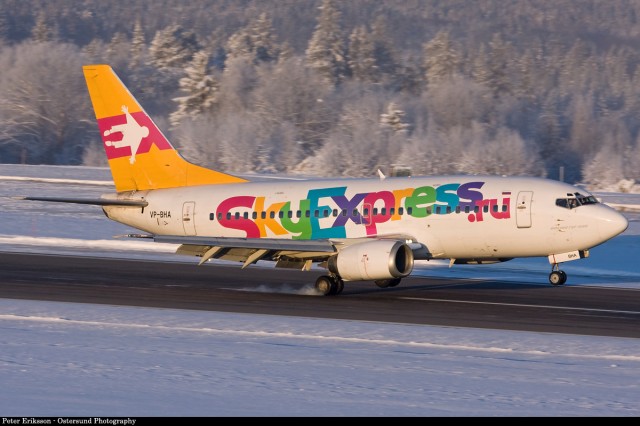
Sky Express Boeing 737-500 in the snow. Photo by Ostersund Photography.
It is a bird. It is a plane… well, it kind of is a plane, but is that a man painted on the tail? It sure is and he is flying.
Unfortunately, the airline doesn’t technically exist and was wrapped in with Kuban Airlines. The plus is Kuban is still flying the Sky Express 737s with their old and colorful livery.
Sky Express started operations in 2007, but went out of business in 2011. It was based at Vnukovo International Airport in Moscow.
It was the first Russian low-cost airline and operated a fleet of Boeing 737-300, 737-500 and Airbus A319.
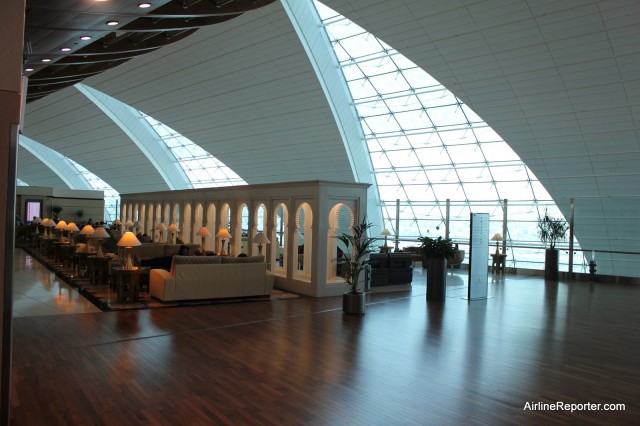
One of the many attractive views inside Emirates First Class Lounge in Dubai
Dubai is known for having impressive and large things. It makes sense then that Emirates Airlines would have a huge, and impressive, First Class Lounge at their main hub in Terminal 3 at Dubai International Airport (DXB).
Getting access to any lounge is a nice benefit — but not all lounges are created equal. Most of the time, those paying $20,000 for their First Class international ticket do not want to mingle with those who paid a mere $7,000, and they do not have to. We aren’t in Kansas anymore folks.
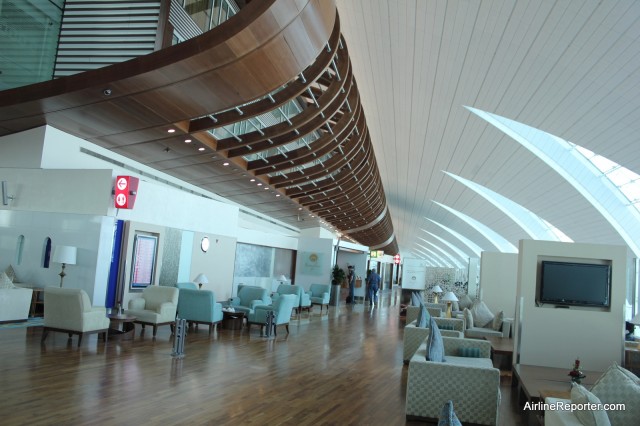
The First Class Lounge seems to go on forever in Dubai
First of all, the lounge is frek’n huge. It took a good ten minutes for me to do a lap around the place and I am convinced I still did not see everything. There are some things you would hope to find in any lounge; comfortable seating, easy access to quick food and drink, high-end service, and even showers. But there was more at this lounge that you do not find often.
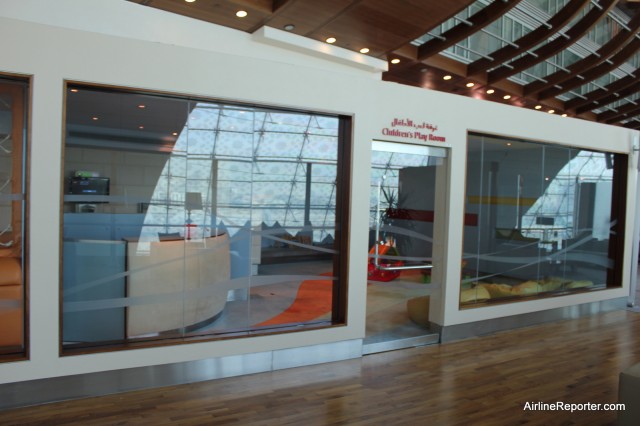
I almost wish there was a play are like this for adults
If you have kids and want to have some time away from them before hopping on a plane for 14 hours, the lounge has its own kids play area. Not only does this allow you the chance to enjoy the rest of the lounge’s amenities with some peace, but it also allows your children to tire themselves out a bit before the flight.
There might not be a real play area for adults, but there is a free spa — called the Timeless Spa. Get a quick massage or facial and it is all complimentary. You just have to add you name to the list, wait your turn, and relax. I wanted to test these services for myself (you know, for the story), but I unfortunately ran out of time.
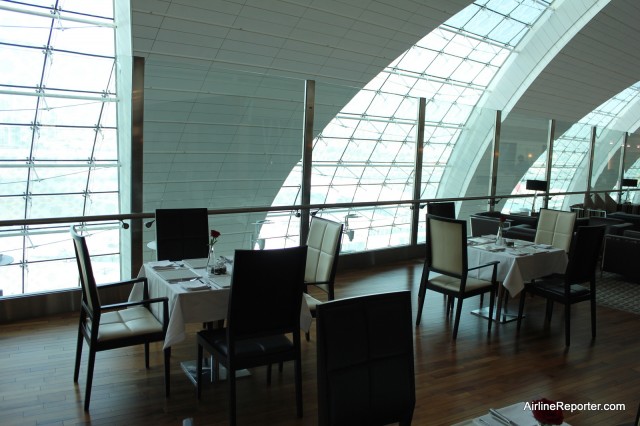
Take a seat at a table or one of the booths inside the restaurant, in the lounge, in the airport, in Dubai.
There are quite a few food options in the lounge — the most impressive being a sit-down restaurant. From snacks to full meals, you surely shouldn’t be leaving the lounge hungry. No matter what you order or get, leave your wallet in place, because there is no additional charge.
If you are more in the mood for some alcohol, no worries, you have lots to choose from. Want to take some wine home with you? No problem — there is a shop in the lounge, where a wine connoisseur will help you pick out that perfect bottle.
One could easily visit the lounge and have a different seating experience each time. From comfy, large seats to a faux living room to working areas, whatever you are looking to do, there is a seat for you.
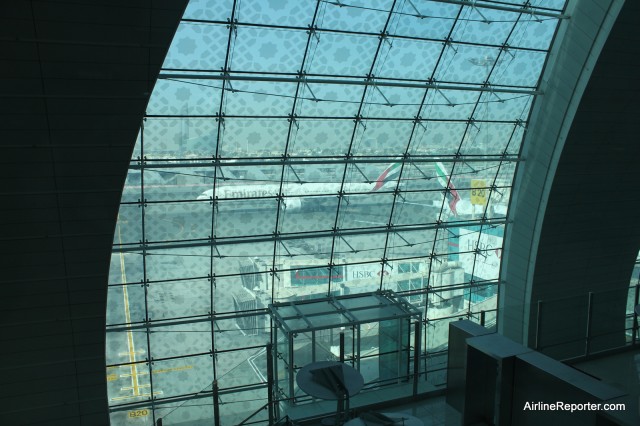
If you are hoping to plane spot from the lounge, or even from Terminal 3, you might be disappointed.
Overall, the lounge was outstanding. However, there were two things that I did not find appealing; one which most people will share in my pain and the other only AvGeeks will.
The biggest disappointment was the Wi-Fi — which was slow. When I say slow… I mean S L O W. It was borderline useless to get any work done. Reading online, I found this was not an isolated experience and seems to be a constant problem.
The second issue I had was the view to the airplanes outside. There are large windows, but they all had markings on them to help keep the interior cool. I was told that the airport also designed the windows in this fashion so that passengers do not feel that they are in an airport. Of course, I like to feel that I am in an airport — oh well.
SEE ALL 13 PHOTOS FROM MY VISIT OF EMIRATES FIRST CLASS LOUNGE IN DUBAI
Hello Everyone!
Sorry about the lack of content yesterday and again today (I don’t count this as content). I have been sick (don’t worry, not serious) and been resting and not able to keep up on the blog. No worries, I am expecting to be back in action tomorrow. I miss talking about airlines.
Cheers,
David
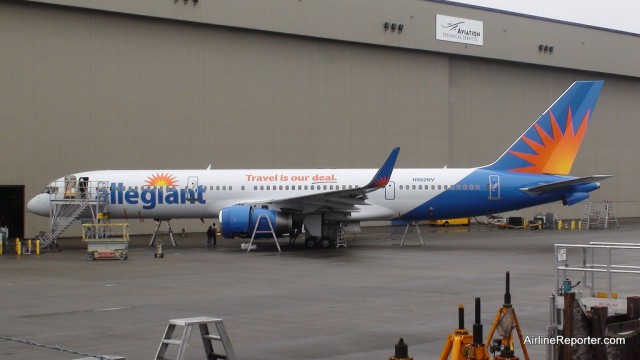
One of Allegiant Air's Boeing 757s (N902NV) while still in Everett, WA.
The journey from rumors that Allegiant Air was to add Boeing 757-200s during the summer 2010 to their fleet to now receiving ETOPS and Flag Carrier Status status from the Federal Aviation Administration has been long.
Last summer, it was a let down for Allegiant, when the FAA gave them authorization to fly the new aircraft type, but they would not give the airline ETOPS certification to fly over the water to Hawaii. Over the past year, Allegiant has been flying a few 757s on routes in the continental US to gain experience. That experience is finally paying off and starting at the end of this month, the airline will start service to Honolulu, followed by Maui in November. Allegiant’s non-stop service plan to Honolulu:
Las Vegas ’“ begins June 29
Fresno, Calif. ’“ begins June 30
Bellingham, Wash. ’“ begins November 15
Monterey, Calif ’“ begins November 16
Eugene, Ore. ’“ begins November 17
Santa Maria, Calif. ’“ begins November 17
Stockton, Calif. ’“ begins November 18
Allegiant will also offer nonstop air service to Maui from:
Bellingham, Wash. ’“ begins November 14
’œThis is an important day for Allegiant,’ Andrew C. Levy, Allegiant Travel Company President, said. ’œObtaining ETOPS and Flag Carrier status not only clears the path for our new service to Hawaii, but also opens up potential international opportunities and will play an important role in our company’s future growth. Our operations team worked long and hard to ensure the completion of this certification and we thank them for their dedication in achieving this important goal.’
Currently, Allegiant operates a fleet of 58 MD-80 aircraft and four Boeing 757-200s. They still have two additional 757s that are being leased. Allegiant plans to put one 757 into service during fourth quarter 2012 and the second first quarter of 2013.
Allegiant is still planning to grow and is looking at other route options. Previously Levy has stated that the airline is looking at the possibility of flying to Canada, Mexico and even South America.
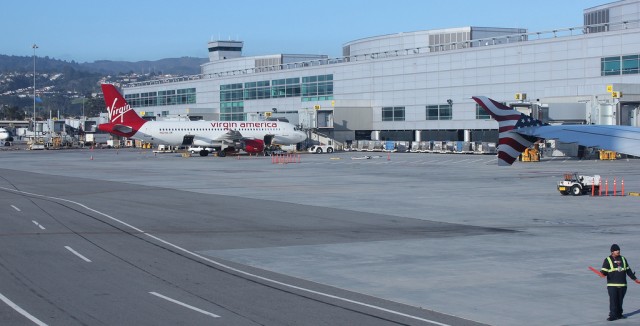
Directly from Virgin America’s Press Release:
San Francisco ’“ June 11, 2012 ’“ Virgin America, the award-winning U.S. airline, announces today that it is requesting U.S. Department of Transportation approval to place the Virgin Australia code on Virgin America services from Los Angeles to Boston, Chicago, Dallas, Fort Lauderdale, Philadelphia, Portland, Seattle and Washington D.C. Once approved, this will be the first-ever codeshare agreement for the California-based carrier, building on a 2009 interline agreement with Virgin Australia that paved the way for a more seamless travel experience for guests flying between Australia and the U.S. This will offer seamless booking on a single ticket for guests traveling from Australia to multiple destinations in the U.S. Virgin America’s recent move to a new reservations system allowed the carrier to initiate this first codeshare alliance as well as significantly expand its interline partnerships in recent months.
’œWe believe this partnership will be welcomed by travelers on both sides of the Pacific, especially our most loyal guests ’“ those who seek out the upscale service and amenities that the Virgin branded carriers are known for around the world,’ said Diana Walke, Virgin America’s Vice President of Planning and Sales. ’œWith touch-screen entertainment, an international grade First Class, a premium Main Cabin Select product and an award-winning Main Cabin ’“ our product offerings are uniquely matched to Virgin Australia. With this new partnership, U.S.-Australia travelers will be assured best-in-class guest service in three well-aligned classes of service ’“ throughout their journey.’
Earlier this year, Virgin America announced an enhancement to its Elevate® frequent flyer program that allows members to earn and redeem points across the combined route network of the Virgin family of carriers. And last month, all three award-winning Virgin airlines ’“ including Virgin Atlantic ’“ joined forces for the first time ever to launch a joint entertainment, digital and out-of-home ’œVirgin Skies’ advertising campaign to convey the unique Virgin in-flight experience in the Los Angeles market and mark the airlines’ global frequent flyer partnership. The centerpiece of the campaign includes the creation of an independent short film shot entirely on three commercial Virgin flights while at 35,000 feet. For more on the campaign, including behind-the-scenes footage from the filming, visit: www.flyvirgin.com/#film
’œThe United States is a very important market for Australia; it is the third most popular international destination for Australian visitors and our fourth biggest source of overseas visitors to Australia,’ said Virgin Australia Group Executive of Alliances, Network and Yield Merren McArthur. ’œToday’s announcement means Virgin Australia guests can connect seamlessly to key leisure and business hubs and earn frequent flyer points and status credits in the process.’
The new codeshare agreement will not change the airlines’ existing interline agreement, through which guests already enjoy a seamless ’œVirgin’ experience at Los Angeles International Airport (LAX). Under the codeshare, guests will check-in once and receive all their boarding passes. Domestic to international connections at LAX are within the same terminal (Terminal 3), so guests traveling from the U.S. to Australia do not have to re-clear security. Both airlines will transfer baggage between connecting flights and to guests’ final destinations ’“ with customs clearance of guests and bags still required for travelers coming from Australia to the U.S.
Note: Press Release posts do not show up on the blog’s homepage and will not show up in syndications… you need the directly link to access.







